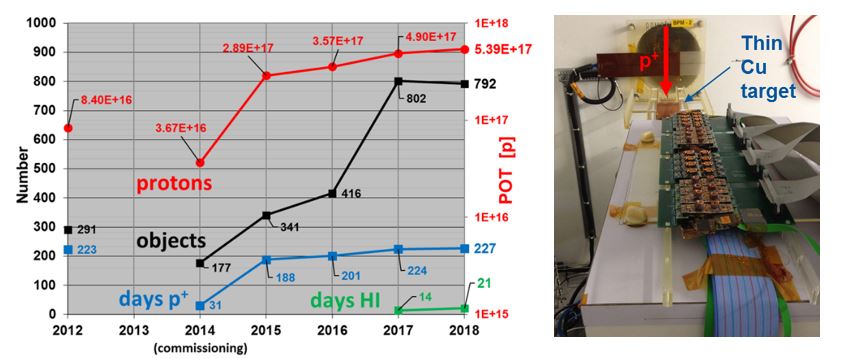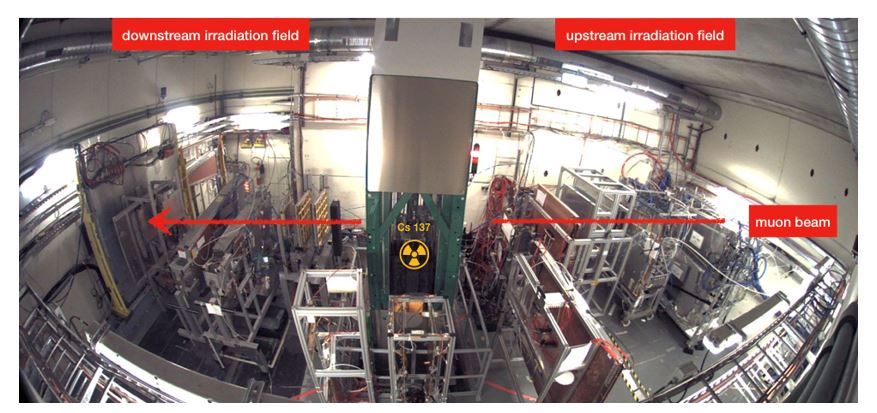A bright year for the EP-DT irradiation facilities
The CERN proton irradiation facility (IRRAD – www.cern.ch/ps-irrad) at the PS East Area and the new gamma irradiation facility (GIF++ - www.cern.ch/gif-irrad) at the SPS North Area have been designed and built during LS1 to cope with the increasing need for irradiation experiments of the EP experimental community, working for the High-Luminosity upgrade of the LHC and beyond. Both these new facilities are the natural upgrade of historical services of the EP department that, since the 90’s, were exploiting the proton beam at the PS and the SPS muon beam (in the former West Area) for studying the radiation hardness of materials and semiconductor devices and to test particle detector prototypes including tracker, calorimeter elements and muon chambers.
The IRRAD facility, operated by a team in EP-DT, is nowadays part of a more complex infrastructure in the PS East Area divided in two separated facilities operating in parallel and sharing the same high-energy proton beam (24 GeV/c) extracted to the T8 beam-line. While in IRRAD, irradiations are performed with the primary protons, in CHARM (located downstream IRRAD and operated by the EN department) a mixed-particle radiation field is generated by a thick target, thus reproducing the radiation environment of the LHC tunnel and the typical shielded areas of the CERN accelerator complex.
IRRAD reached the LS2 after four full consecutive years of operation since 2015. During one year, more than 200 days of beam-time are available for irradiation experiments in IRRAD. As shown in the Figure (LEFT), for about the same beam-time, the number of irradiated samples constantly increased reaching a peak around 800 samples/year during these last two runs before the LS2 (2017-2018). Using the new software application “IRRAD Data Manager”, developed within the AIDA-2020 project (www.cern.ch/irrad-data-manager), about 1000 samples belonging to 81 different irradiation experiments were initially registered in 2018 by the 92 users of the facility. The final number of irradiated objects takes into account the final samples availability, the daily operational constraints (as the maximum interaction length allowed in the facility, etc.) and a fair distribution of the beam-time among the users. As in 2017, this exceptional performance was possible also thanks to the excellent availability and quality of the irradiation beam provided by the BE-OP team that, also in this last run before LS2, reached the level of 5x1017 protons delivered to IRRAD.
Fig. 1. – Left: Statistics for the IRRAD facility during its first run (2014-2018). The number of irradiated objects and days of proton and Heavy Ion (HI) beam time (left vertical axis), as well as the total number of protons delivered to IRRAD (right vertical axis), are plotted for the last 7-years of operation. Right: Irradiation of the FEAST2 DC/DC converters during 2018. The secondary particle field generated by the thin copper target (visible upstream in the picture) impinges on the samples irradiated at room temperature located on the top and inside the thermal box (visible in the foreground) where a temperature of -25ºC and low RH are maintained.
About 30% of the irradiated samples in 2018 were belonging to the R&D collaborations, mainly RD50 and RD53, as well as belonging to common development and R&D projects for future accelerators (FCC). Another 50% of samples came from the LHC experimental collaborations. This includes the ATLAS, CMS, LHCb and TOTEM experiment. The final 20% were samples for radiation hardness studies belonging to LHC equipment groups in the EN and TE department (electrical distribution, magnets, vacuum, cryogenics, etc.) as well as to the CERN safety unit (HSE). During 2018, a special experiment also took place in IRRAD and required to setup a “thin” copper target to locally generate a stray secondary particle field. These special irradiation conditions, setup for the very first time in IRRAD, enabled the testing of the FEAST2 DC/DC converters developed by the EP-ESE group in different environmental conditions (see Figure 1 – right).
Finally, the last 3 weeks of the run 2018 were again dedicated to the development and characterization of an 82Pb Heavy-Ion (HI) beam on T8. Several dosimetric measurements were performed with the main goal to provide a beam for Single Event Effect (SEE) studies in electronic components for space application, as well as to evaluate the possibility to propose, after LS2, the East Area facility as a test-bench for the experimental collaborations involved in HI physics.
The IRRAD team in EP-DT is now preparing the work for LS2 where several maintenance interventions are planned in order to mitigate the radiation-induced damage on the various irradiation equipment of the facility. Moreover, an extension of the IRRAD technical area (used for the storage, handling and characterization of the irradiated samples) is also foreseen in the framework of the ongoing East Area renovation project.
The GIF++was constructed as a joint project between the CERN engineering and physics departments and commissioned in late 2014, replacing the original Gamma Irradiation Facility in the West Area that had lost access to a muon beam in 2004. Especially designed for testing gas based muon detectors for the upgrade program of the LHC experiments, GIF++ is a unique place where high energy charged particle beams, mainly muons with momenta up to 100 GeV/c, are combined with a 14 TBq 137Cs source (as of 2014), roughly 30 times the photon intensity of the previous facility. The 100 m2 irradiation bunker has two independent irradiation zones – both equipped with an angular correction filters and an absorption filter system - making it possible to simultaneously test several real size detectors, up to several m2, as well as a broad range of smaller prototype detectors and electronic components. The facility is equipped with a central control system to record all relevant environmental parameters, beam parameters, filter settings, as well as to redirect interlocks on gas mixtures qualities supplied to the detectors. A wide range of readily available gases can be used by connecting to the gas panels distributed throughout the facility.
Since 2015, the facility users are coordinated by EP-DT. The facility operates in two main modes: throughout the year, the gamma irradiation is available - only interrupted by short maintenance periods – and work concentrates on ageing studies and radiation hardness of components. The absorption filters (and distance from the source) are used to control the level of radiation and therefore the acceleration factor for the ageing studies. During 6-9 weeks per year, the facility also receives the muon beam from the T2 target and work concentrates on performance tests of the muon detectors under varying background condition. In this second mode, the gamma field intensity is tuned to simulate the radiation background these chambers will experience in their final positions inside the LHC experiment during HL-LHC conditions.
Typically, the facility hosts up to 20 detector setups per year requiring muon beam, in addition to several setups requesting gamma irradiation only. Due to the size of the setups, a maximum of 9-11 setups along the beamline in total can be fitted inside the irradiation bunker, distributed along the two fields as shown in Fig.2. While the majority of installed systems come from the LHC experiments, GIF++ regularly hosts setups from other departments (e.g. Beam-Loss Monitors for BE) or different research facilities (e.g. muon detectors for CBM/FAIR). Over the last years, the search for new environmentally friendly gas mixtures and the test of gas recycling systems also became a mayor field of research at GIF++.
Fig.2 – GIF++ irradiation bunker during October Muon beam time 2018. Up to 11 different setups – often composed of multiple chambers – could be hosted along the muon beam, while several other experiments could continue to use only the irradiator.
In contrast to other CERN irradiation facilities, the GIF++ irradiator will be fully operational during LS2 - as much as the ongoing consolidation works in EHN1 will permit it. The work load will even intensify in the coming two years, with 4 major mass-production campaigns announced, while the majority of long-term ageing tests will continue. The tests for the ATLAS and ALICE muon detectors have already started in 2018, both requiring frequent access to the irradiation bunker to exchanges chambers.
Due to the success of the facility and its increasing user base, the GIF++ is constantly overbooked, with the space inside the bunker being one of the main limitations. Thanks to the financial support from all four LHC experiments as well as the EP and EN departments, the bunker will be significantly extended in the upstream direction during LS2, adding more than 40 m2 of irradiation area. The design of the extension has been finalised, with work expected to start in mid-2019 and lasting for 4 weeks. The increased distance from the source (+ 9 m) will allow to place low-intensity irradiation tests further away, removing the need for high absorption filters and increasing the photon intensity for other long-term setups running in parallel. This will ease the space constraints during the mass production campaigns, and will be a big step in optimising the usage of the muon beam during the LHC - Run 3 with better access to the individual setups and the possibility to host an even increased number of detectors for HL-LHC studies and beyond.
The IRRAD and GIF++ facilities are also part of the AIDA-2020 Transnational Access to irradiation facilities program that provides funding for external users to perform their irradiation tests at CERN. While IRRAD will resume operation only after the LS2, GIF++ will continue to be operational (for gamma irradiations only and compatibly with the upgrade works detailed above) and some Transnational Access funds remain available for the facility users. More details are available here: http://aida2020.web.cern.ch/content/how-apply-transnational-access
The EP-DT Irradiation Facilities team: J. Bronuzzi, B. Gkotse, M. Glaser, G. Gorine, M. Jaekel, I. Mateu, G. Pezzullo and F. Ravotti


